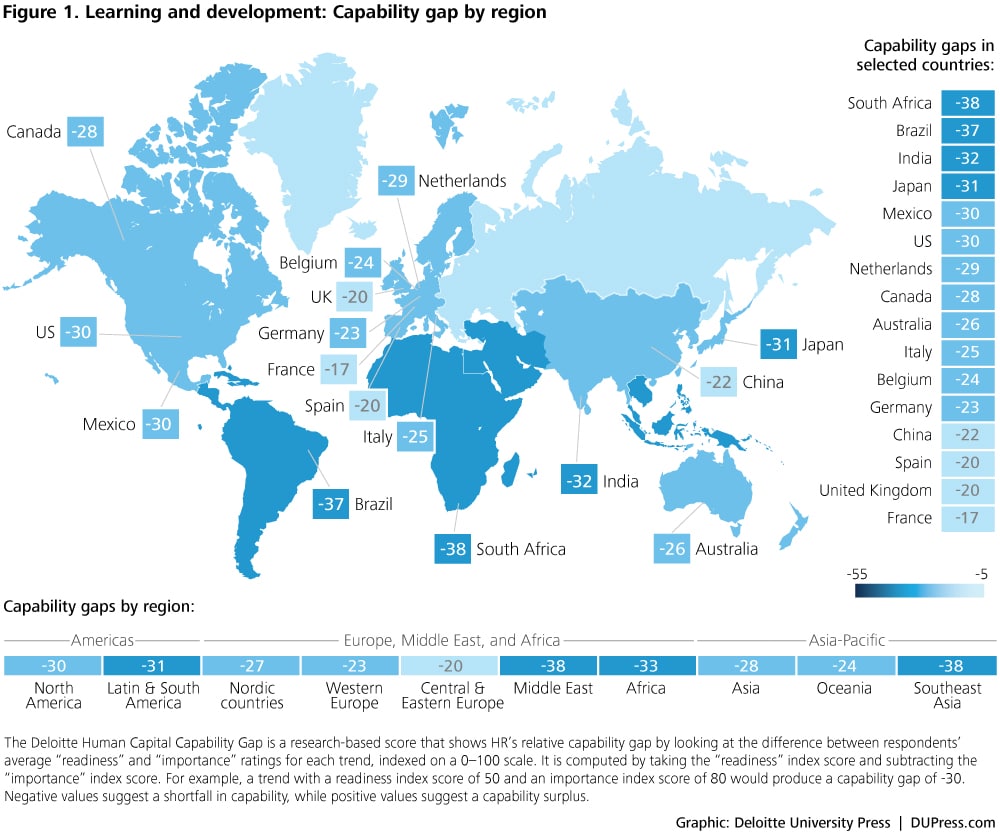Learning and development has been saved

Learning and development Into the spotlight
28 February 2015
Companies see an urgent need to build skills and capabilities, and they are now focused on transforming their learning organizations and strategies.
- Companies see an urgent need to build skills and capabilities and are now focused on transforming their learning organizations and strategies.
- Learning and development issues exploded from the No. 8 to the No. 3 most important talent challenge in this year’s study, with 85 percent of survey participants rating learning as a “very important” or “important” problem. Despite this demand, capabilities in learning dropped significantly; the gap between importance and readiness was more than three times worse in 2015 than in 2014.
- Companies that transform their learning and development organizations are not only able to accelerate skills development, but also can dramatically improve employee engagement and retention—one of the biggest challenges cited by this year’s respondents.1
Explore
Explore the interactive trends dashboard
Create and download a custom PDF of the Human Capital Trends 2015 report.
This year, corporate learning and development (L&D) burst onto the scene as one of the most pressing business and talent issues facing our respondents.2 Business and HR leaders report that corporate learning capabilities are waning (39 percent say the problem is “very important,” more than three times last year’s percentage), and companies are now competing heavily for new technical and professional skills. This research tells us that 2015 will be a critical year for targeted investment in learning.
In this year’s Global Human Capital Trends survey, more than 8 out of 10 (85 percent) respondents cited learning as “important” or “very important,”—up 21 percent from last year. Yet, in a troubling development, more companies than ever report they are unprepared to meet this challenge. The capability gap between the importance of the issue and the ability to respond grew in magnitude by an enormous 211 percent over the last 12 months (from -9 to -28).3 (See figure 1 for capability gaps across regions and selected countries, and figure 2 for year-over-year changes in the gap.)

Why the huge increase in need and growing gap in capability?
To start with, senior business leaders increasingly see shortages of skills as a major impediment to executing their business strategies. Only 28 percent of the respondents to this year’s survey believe that they are “ready” or “very ready” in the area of workforce capability. As the economy improves and the market for high-skill talent tightens even further, companies are realizing they cannot simply recruit all the talent they need, but must develop it internally.
 Faced with gaps in talent and skills, CEOs are turning to CHROs and CLOs to ask for more and better learning platforms and products. Just when the need is most urgent, HR organizations face a massive digital transformation in the learning and training industry, plus new expectations by employees for on-demand learning opportunities.
Faced with gaps in talent and skills, CEOs are turning to CHROs and CLOs to ask for more and better learning platforms and products. Just when the need is most urgent, HR organizations face a massive digital transformation in the learning and training industry, plus new expectations by employees for on-demand learning opportunities.
The last three years have witnessed an explosion of new learning offerings, including MOOCs (more than 400 universities now offer free or low-cost courses), digital learning tools, video offerings, and new cloud-based training systems. These new learning platforms are easy to use, provide access to internal and external content, and use analytics to recommend content in a manner similar to Netflix and Amazon.
Innovative and engaging learning solutions today are on-demand, fast to absorb, and available on mobile devices.4 Yet, while employees now demand a personalized, digital learning experience that feels like YouTube, many companies are stuck with decades-old learning management systems that amount to little more than a registration system or course catalog. Research shows that less than 25 percent of companies feel comfortable with today’s digital learning environment.5 This year’s trends survey results support this: Only 6 percent of respondents rate themselves excellent at providing mobile learning, only 6 percent rate themselves excellent at incorporating MOOCs into their learning and development programs, and only 5 percent rate themselves excellent at using advanced media such as video, audio, and simulations—essential capabilities in a world dominated by digital learning platforms.
This may be starting to change, however. Many companies are starting to invest more heavily in learning and development to build the skills they need.
Last year, the learning and development market grew by 14 percent, while spending on leadership development grew at an even faster rate.6 The learning technology market grew by 27 percent and is now a $4 billion industry.7 Last year, more than $400 million was invested in fast-growing learning providers such as EdX, Khan Academy, Coursera, and Udemy, which have emerged as large marketplaces for online training, serving millions of users after only a few years of operation.8
But new technology is only one part of a learning transformation. Companies such as Philips are rationalizing their distributed learning teams, cutting down on duplicative content, and consolidating technologies to build an integrated, consistent learning environment.9 MasterCard ties learning directly to business strategies and has assigned product managers to help make sure learning is directly relevant to individual employees.10
And technology is no substitute for the expertise of a company’s own people. Companies are also increasingly unleashing the power of their own experts. Google’s Googler-to-Googler program is one good example of how companies promote a learning culture. Karen May, Google’s head of people operations, says that giving employees teaching roles makes learning a natural part of the way employees work together, rather than something HR is making them do.11
Deckers Outdoor, a leading shoe manufacturer (the maker of Ugg footwear and other well-known brands), has redefined its learning strategy as a critical part of employee engagement, communications, and culture. Not only has Deckers revitalized its digital learning experience, but the company also considers all learning programs to be programs to engage people and drive the corporate culture. Each program includes an element of “why” and communicates purpose and meaning, not just content. This approach fits in with Deckers’ culture of not merely “teaching people,” but “inspiring people to learn.”12
With a background in employee development, change, and leadership, the CLO of today wears many hats: chief capability officer, chief leadership officer, chief talent officer, and even chief culture officer.
Deckers’ head of L&D is also responsible for employee engagement, culture, and employee communications. Her team tells stories about learning successes and career growth; they give people artifacts to take to their desks to remind them to learn; and they focus on change management and communication as an integral part of the learning environment. The result is not only strong business results but also one of the lowest turnover rates in the industry.
Beyond filling skill and capability gaps, some companies are realizing other goals through learning and development transformation. TELUS, one of Canada’s fastest-growing telecommunications companies, recently revitalized its learning platforms with improved technology, the assignment of “product managers for learning” within L&D, and the adoption of new contextual learning tools. Following these steps, employee retention improved by 30 percent.13
As companies begin the transformation process, chief learning officers are taking on critical business roles. With a background in employee development, change, and leadership, the CLO of today wears many hats: chief capability officer, chief leadership officer, chief talent officer, and even chief culture officer.14
Lessons from the front lines
Nestlé recently completed a review of how learning could play a more strategic role in a world dominated by the need for innovation, agility, and social, mobile, and digital technology.
The company’s CLO, Fausto Palumbo, presented a bold view that learning could be a strategic lever within the organization to change the way employees think and act. This led to a review of enterprise-wide leadership programs and the initiation of a pilot program with the mission of reimagining the learning experience for senior executives.
Instead of a lecture-based program, Nestlé developed a multifaceted experiential learning model that included a wide variety of activities:
- A multi-day, high-stress simulation around key leadership topics
- Reactions to real-time/simulated data from product-specific social and mobile feeds
- Product development by widely distributed design and development teams using digital technologies
- Prototype development of new products using digital printing
To ensure that learning was not an isolated event but rather integrated into daily work, the company set up a series of video and digital presentations before the live learning module was launched; it also built follow-up events.
Through this learning program, the next generation of senior leaders were rapidly introduced to a social and mobile world where agility and innovation are the disruptive norms. The pilot provided the foundation for how the company will use learning to drive its agenda in a digital world where social and mobile need to be part of every executive’s toolkit. With the success of the pilot, the learning team is now moving quickly to reinvent other critical leadership programs.
Where companies can start
- Reimagine the learning experience: This year is the time to reimagine and redesign your learning experience. Look at your learning management systems and content strategy, and expand your thinking to create an environment that attracts and encourages people to learn.
- Assess your current learning offerings: Analyze where your current L&D money is going. Research shows that most companies underestimate their spending by a factor of two to three, and many have uncoordinated and duplicative programs and tools throughout the company.15 A project to find and rationalize learning spending often identifies areas to reengineer with little incremental investment.
- Centralize spending and strategy while carefully distributing learning capabilities: Great learning teams have a strong leader and spend money strategically, with centralized operations focused on technology, content, tools, and methods. They focus on technical, professional, and leadership programs across the company. They distribute programs locally, leveraging centralized infrastructure and common learning elements.
- Assign a learning technology and design thinking team: Companies need to redefine learning as an agile and routine experience. This often requires the assignment of a development team to build a new “learning architecture” as well as assigning people to be “product managers,” not just instructional designers.
- Reimagine measurement: The old measurement models no longer provide enough information. Look at measuring all types of activity, and capture data about learning like you do from outside customers. Monitor metrics such as activity and usage, feedback, and net promoter scores, as well as satisfaction and instructor ratings.
- Elevate the job of chief learning officer: In times like these the CLO plays a critical role. Elevate this position to attract experienced learning, technology, and HR leaders. The CLO must create a vision for the future, put in place a business and operating plan that scales, centralize strategy and architecture, and engage top leadership in building a learning culture.
BOTTOM LINE
Learning today has become a business-critical priority for increasing skills, improving the leadership pipeline, and enhancing employee engagement. As the corporate learning market undergoes a digital transformation, this is the year to assess your current learning environment and implement a new vision to build a corporate learning experience that touches every employee in a significant way.
© 2021. See Terms of Use for more information.





